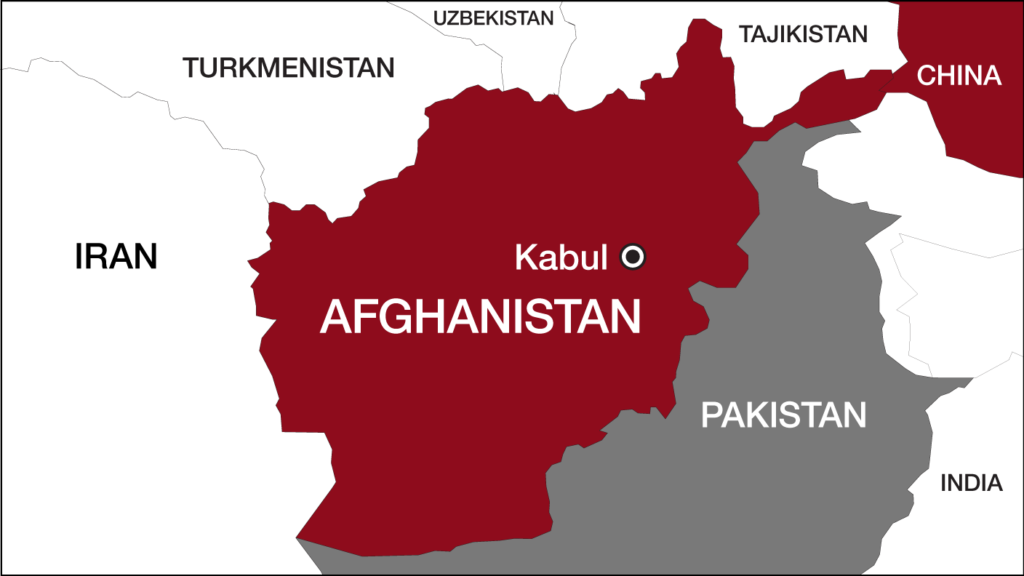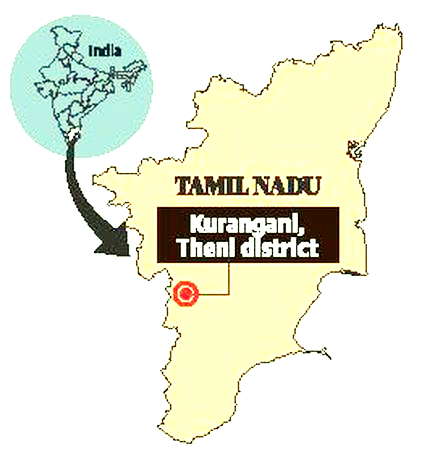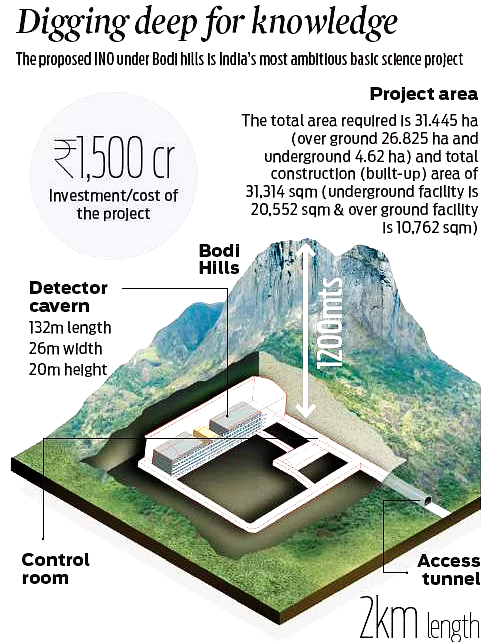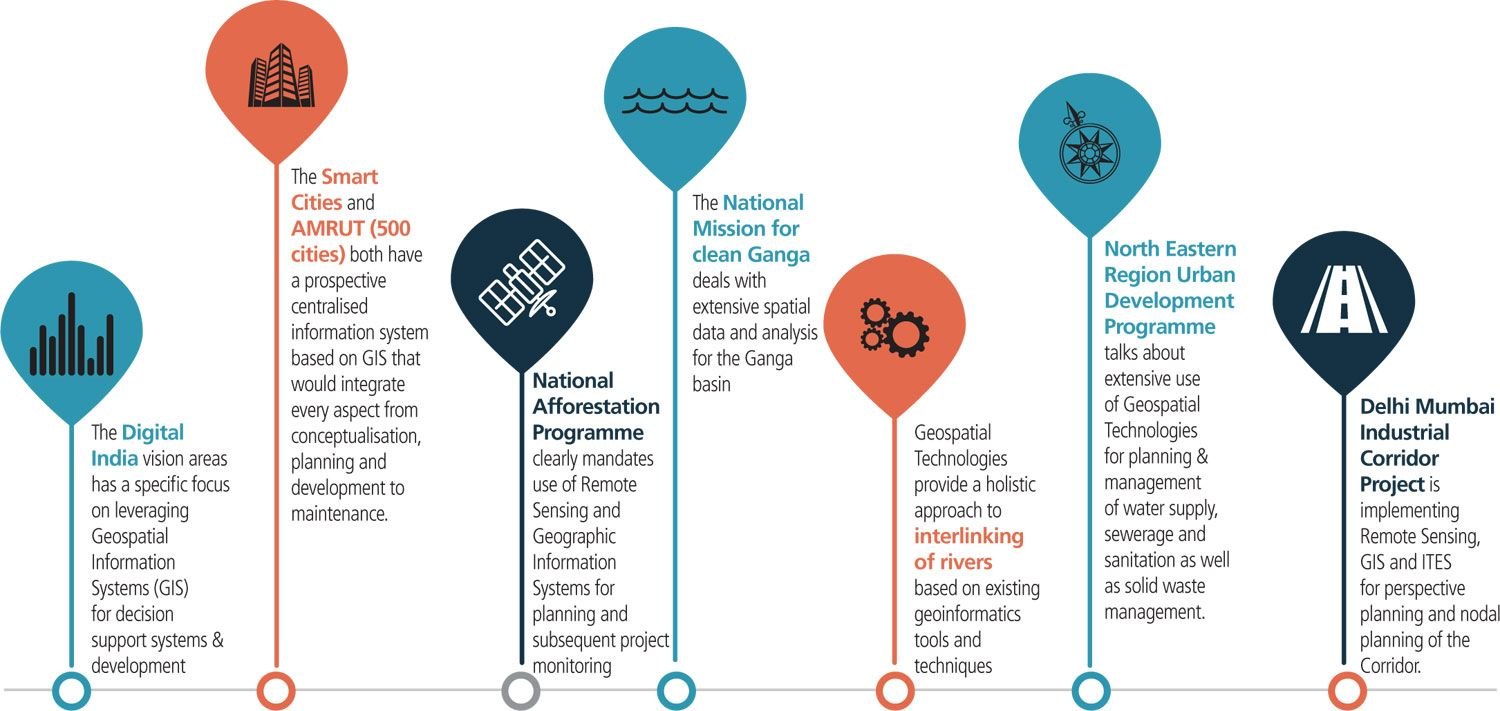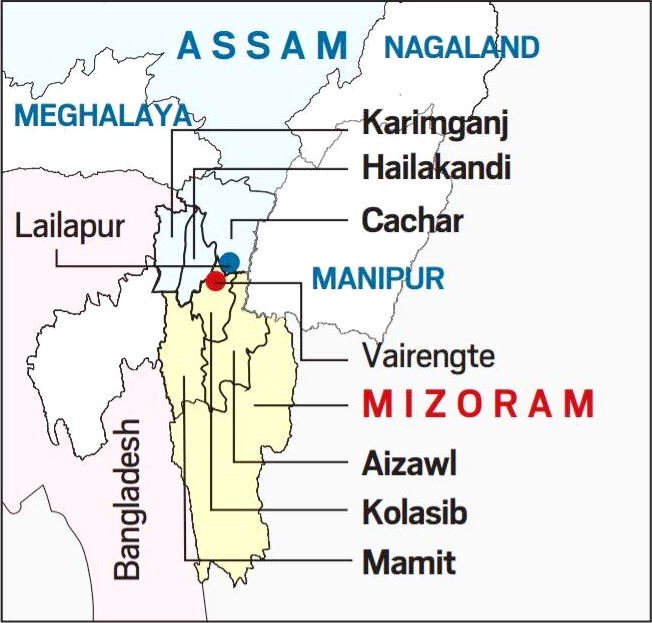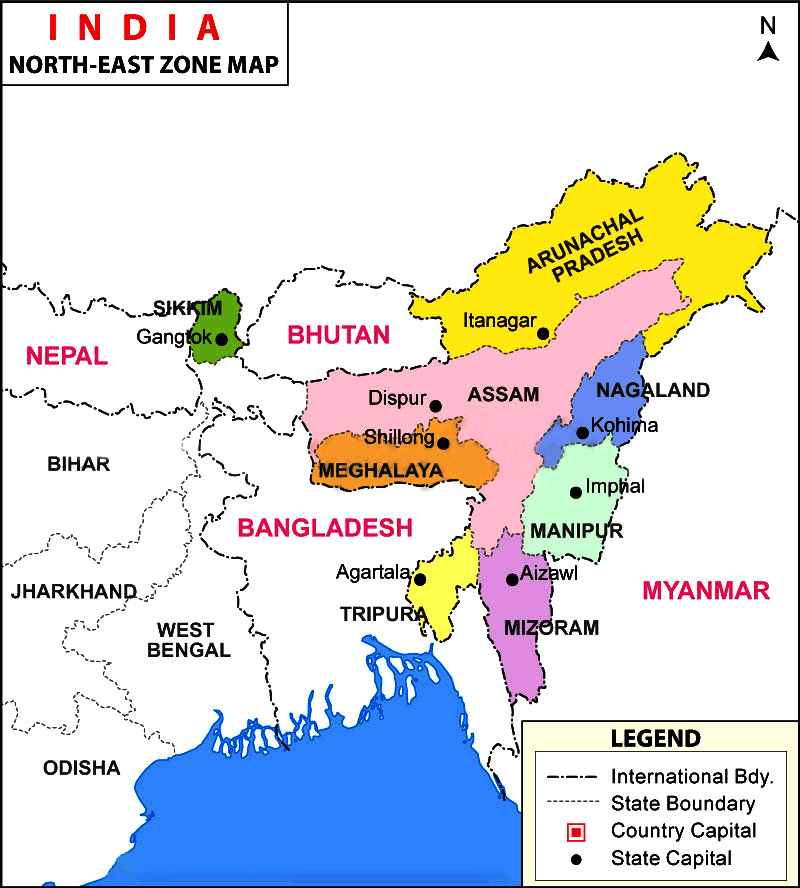Afghanistan’s Humanitarian Crisis
For Prelims: Afghanistan, World Bank, Delhi Regional Security Dialogue, Taliban, Islamic State.
For Mains: India and its Neighbourhood, Effect of Policies & Politics of Countries on India's Interests, Crisis in Afghanistan and its Implications.
Why in News?
Recently, the World Bank has approved a plan to use some USD 1 billion in a frozen Afghanistan trust fund for education, agriculture, health and family programs to ease the country's worsening humanitarian and economic crises.
- The aim is to protect the vulnerable, help preserve human capital and key economic and social institutions and reduce the need for future humanitarian assistance.
- Earlier, the Delhi Regional Security Dialogue on Afghanistan was held in India.
What is the Current Situation in Afghanistan?
- An insecure Afghanistan has not only dangerous implications for the region but also the whole world.
- Afghanistan has been unstable and insecure for decades, but the Taliban’s capture of power in August 2021 has had the entire region hanging by a thread.
- The current situation in Afghanistan is disturbingly similar to the geopolitical scenario in the late 1990s.
- The Taliban seized power in 1996, but the international community did not fully grasp the potential consequences of the new paradigm.
- International aid organisations have left the country. The Taliban are unable to pay the wages to government employees. The public health care sector is in a disarray.
- The war-ravaged country is facing an unprecedented humanitarian crisis, which could turn into another violent conflict.
- Apart from the suffering of the rural population, even Afghans based in cities are finding it impossible to make ends meet.
- Afghanistan could face a bigger catastrophe if the Taliban are unable to improve the economic situation, adding that they will find it difficult to govern and a civil war could erupt.
- It is easier for terrorist groups to operate in a country that is facing economic turmoil. Afghanistan is no exception.
What are the Impacts of the Humanitarian Crisis in Afghanistan?
- Many western nations see an immediate security threat emanating from Afghanistan. The Taliban, seeking to gain international recognition and financial aid, are more inclined toward a “diplomatic” approach than employing violent tactics. But this superficial calm may not last for long.
- If the humanitarian crisis aggravates in Afghanistan, even the Taliban won’t be able to manage the situation, as evidenced by violent “Islamic State” (IS) attacks.
- A possible violent conflict in Afghanistan could spill over to other countries in the region.
- If that happens, regional powers will start supporting proxies to keep the violence within Afghanistan’s boundaries. But it will only be a short-term solution to the Afghan conflict.
- The more the Taliban stay in power, the more difficult it will get to maintain stability in the region.
- The Taliban have ties with international terrorists. Their return to power has emboldened jihadi organizations in the region.
- As they consolidate themselves, their tactical and strategic ties with terrorism financiers and sponsors will grow and will eventually jeopardize peace and security in the region and beyond.
What should the World do for Afghanistan?
- The humanitarian crisis in Afghanistan cannot be resolved through humanitarian aid alone.
- Afghanistan’s economy needs to be improved so that Afghans can be brought out of poverty.
- But to lift Afghanistan’s economy, the international community needs to engage with the Taliban.
- Terrorism will not be contained within Afghanistan’s borders if the humanitarian situation in the country does not improve.
What will be the Implications on India?
- Strategic Concern:
- The Taliban’s control will also mean a bigger hand for the Pakistani military and intelligence agencies to influence outcomes for the country, which will mandate a much smaller role for Indian development and infrastructure work that has won it goodwill over the past 20 years.
- Threat of radicalisation:
- There is the threat of growing radicalisation and space for pan-Islamic terror groups in India’s neighbourhood.
Way Forward
- Inclusive Government: The solution comes only through the formation of an inclusive government with the participation of all ethnic groups.
- Russian Support: Russia has cultivated links with the Taliban in recent years. India would need Russia’s support in any form of direct engagement with the Taliban.
- Bonhomie With China: India should talk with China, with the objective of finding a political settlement and lasting stability in Afghanistan.
- Engaging with Taliban: Talking to the Taliban would allow India to seek security guarantees from the insurgents in return for continued development assistance or other pledges as well as explore the possibility of the Taliban’s autonomy from Pakistan.
Plastic Waste Management (Amendment) Rules, 2022
For Prelims: Single Use Plastics and its uses, Extended Producer Responsibility (EPR), Paris Agreement, Net Zero, Plastic Waste Management (Amendment) Rules, 2022.
For Mains: Single use plastics and related concerns, Need for alternatives of Single use plastics, Plastic Waste Management (Amendment) Rules, 2022 and its significance.
Why in News?
Recently, the Ministry of Environment, Forest, and Climate Change announced the Plastic Waste Management (Amendment) Rules, 2022, which notified the instructions on Extended Producer Responsibility (EPR) for plastic packaging.
- Plastic Waste Management Rules 2016 has been amended to fast-track the elimination of single-use plastics and promote alternatives.
- The term Extended Procedure Responsibility means the responsibility of a producer for the environmentally sound management of the product until the end of its life.
What are Plastic Waste Management Rules 2016?
- It mandates the generators of plastic waste to take steps to minimize generation of plastic waste, prevent littering of plastic waste, and ensure segregated storage of waste at source among other measures.
- The rules also mandate the responsibilities of local bodies, gram panchayats, waste generators, retailers and street vendors to manage plastic waste.
What are the Provisions under the New Rules?
- Classification of Plastics:
- Category 1: Rigid plastic packaging will be included under this category.
- Category 2: Flexible plastic packaging of single layer or multilayer (more than one layer with different types of plastic), plastic sheets and covers made of plastic sheet, carry bags, plastic sachet or pouches will be included under this category.
- Category 3: Multi-layered plastic packaging (at least one layer of plastic and at least one layer of material other than plastic) will be included under this category.
- Category 4: Plastic sheet or like used for packaging as well as carry bags made of compostable plastics fall under this category.
- Plastic Packaging:
- Reuse of rigid plastic packaging material has been mandated in the guidelines to reduce the use of fresh plastic material for packaging.
- The enforceable prescription of minimum level of recycling of plastic packaging waste collected under EPR along with use of recycled plastic content will further reduce plastic consumption and support recycling of plastic packaging waste.
- Reuse of rigid plastic packaging material has been mandated in the guidelines to reduce the use of fresh plastic material for packaging.
- Extended Producer Responsibility Certificates:
- In a significant first, the guidelines allow for sale and purchase of surplus extended producer responsibility certificates.
- This will set-up a market mechanism for plastic waste management.
- In a significant first, the guidelines allow for sale and purchase of surplus extended producer responsibility certificates.
- Centralised Online Portal:
- The government has also called for establishing a centralised online portal by Central Pollution Control Board (CPCB) for the registration as well as filing of annual returns by producers, importers and brand-owners, plastic waste processors of plastic packaging waste by 31st March, 2022.
- It would act as the single point data repository with respect to orders and guidelines related to implementation of EPR for plastic packaging under Plastic Waste Management Rule, 2016.
- The government has also called for establishing a centralised online portal by Central Pollution Control Board (CPCB) for the registration as well as filing of annual returns by producers, importers and brand-owners, plastic waste processors of plastic packaging waste by 31st March, 2022.
- Environmental Compensation:
- Environmental compensation will be levied based upon polluter pays principle, with respect to non-fulfilment of EPR targets by producers, importers and brand owners, for the purpose of protecting and improving the quality of the environment and preventing, controlling and abating environment pollution.
- The Polluter Pays Principle imposes liability on a person who pollutes the environment to compensate for the damage caused and return the environment to its original state regardless of the intent.
- Environmental compensation will be levied based upon polluter pays principle, with respect to non-fulfilment of EPR targets by producers, importers and brand owners, for the purpose of protecting and improving the quality of the environment and preventing, controlling and abating environment pollution.
- Committee to Recommend Measures:
- A committee constituted by the CPCB under the chairmanship of CPCB chairman will recommend measures to the environment ministry for effective implementation of EPR, including amendments to Extended Producer Responsibility (EPR) guidelines.
- Annual Report on EPR Portal:
- State Pollution Control Board (SPCBs) or Pollution Control Committees (PCCs) have been tasked to submit an annual report on EPR portal with respect to its fulfillment by producers, importers and brand-owners and plastic waste processors in the state/Union Territory to the CPCB.
What is the Significance of the Guidelines?
- It will promote development of new alternatives to plastics and provide a roadmap for businesses to move towards sustainable plastic packaging.
- The guidelines provide a framework to strengthen the circular economy of plastic packaging waste.
- A circular economy depends on reuse, sharing, repair, refurbishment, remanufacturing and recycling of resources to create a closed-loop system, minimising the use of resources, generation of waste, pollution and carbon emissions.
- These are important steps for reducing pollution caused due to littered plastic waste in the country.
- India generates about 3.4 million tonnes of plastic waste annually. The United Nations Development Programme aims to almost triple its plastic waste management to 100 cities in India by 2024.
- Accumulation of plastic waste is detrimental to the environment and when this waste finds its way into the sea, there can be major harm to aquatic ecosystems, too.
What are the other Initiatives taken to Curb Plastic Waste?
- Swachh Bharat Mission
- India Plastics Pact
- Project REPLAN
- Un-Plastic Collective
- GoLitter Partnerships Project
Way Forward
- A blanket ban will not stop manufacturers from producing single-use plastic products.
- Finding substitutes for use-and-throw plastic and ensuring alternative livelihoods for producers, waste pickers and other groups involved in the business will go a long way in solving the problem.
- The government should not only place fines for not adhering to the guidelines but incentivise producers to switch to more sustainable products. Along with proper monitoring, promoting responsible consumerism is very important.
- Citizens also have to bring behavioural change and contribute by not littering and helping in waste segregation and waste management.
Green Hydrogen/Green Ammonia Policy
For Prelims: Green Hydrogen, Forms of Hydrogen, National Hydrogen Mission.
For Mains: Green Hydrogen and its significance in achieving India’s target of becoming carbon neutral by 2070, Government Policies & Interventions, Environmental Pollution & Degradation, Conservation.
Why in News?
Recently, the Ministry of Power has notified Green Hydrogen/Green Ammonia Policy for production of Green Hydrogen or Green Ammonia using renewable sources of energy.
- National Hydrogen Mission launched in 2021 aims to aid the government in meeting its climate targets and making India a green hydrogen hub.
What are the Provisions of the Green Hydrogen/Green Ammonia Policy?
- Under the policy, the government is offering to set up manufacturing zones for production, connectivity to the ISTS (Inter-State Transmission System) on priority basis, and free transmission for 25 years if the production facility is commissioned before June 2025.
- This means that a green hydrogen producer will be able to set up a solar power plant in Rajasthan to supply renewable energy to a green hydrogen plant in Assam and would not be required to pay any inter-state transmission charges.
- Besides, producers will be allowed to set up bunkers near ports for storage of green ammonia for export by shipping.
- Production target has also been raised five times from 1 million tonnes (m) to 5 mt by 2030.
- In October, 2021 it was announced that India is targeting initially around 1 million tonnes annual green hydrogen production by 2030.
- Manufacturers of Green hydrogen and ammonia are allowed to purchase renewable power from the power exchange or set up Renewable Energy (RE) capacity themselves or through any other developer, anywhere.
- Further, it provides facility for producers to bank any surplus renewable energy generated with discoms (power distribution companies) for upto 30 days and use it as required.
- Discoms may also procure renewable energy to supply green hydrogen producers but will be required to do so at a concessional rate which will only include the cost of procurement, wheeling charges and a small margin as determined by the state commission, under the new policy.
- Such procurement would also count towards a state’s Renewable Purchase Obligation (RPO) under which it is required to procure a certain proportion of its requirements from renewable energy sources.
- To ensure ease of doing business a single portal for carrying out all the activities including statutory clearances in a time bound manner will be set up by MNRE (Ministry of New and Renewable Energy).
What is Green Hydrogen?
- About:
- It is produced by splitting water into hydrogen and oxygen using an electrolyzer powered by renewable energy sources such as wind and solar.
- The fuel can be a game-changer for the energy security of India, which imports 85% of its oil and 53% of gas requirements.
- To promote clean fuels, India is considering making it mandatory for fertilizer plants and oil refineries to purchase green hydrogen.
- Significance:
- Green hydrogen energy is vital for India to meet its Nationally Determined Contribution (INDC) Targets and ensure regional and national energy security, access and availability.
- Green Hydrogen can act as an energy storage option, which would be essential to meet intermittencies (of renewable energy) in the future.
- In terms of mobility, for long distance mobilisations for either urban freight movement within cities and states or for passengers, Green Hydrogen can be used in railways, large ships, buses or trucks, etc.
- Hydrogen has the potential to be the key renewable target in supporting infrastructure as well.
What is Green Ammonia?
- About:
- Ammonia is a chemical which is used mainly in the manufacture of nitrogenous fertilizers, like urea and ammonium nitrate, but can be put to other uses too, such as to run engines.
- Green ammonia production is where the process of making ammonia is 100% renewable and carbon-free.
- One way of making green ammonia is by using hydrogen from water electrolysis and nitrogen separated from the air. These are then fed into the Haber process (also known as Haber-Bosch), all powered by sustainable electricity.
- In the Haber process, hydrogen and nitrogen are reacted together at high temperatures and pressures to produce ammonia, NH3.
- Significance:
- Green ammonia is intended to be used in the production of carbon-neutral fertiliser products, decarbonising the food value chain, and also has potential as a future climate-neutral shipping fuel.
- Green ammonia production makes use of renewable energy sources such as hydro-electric, solar power or wind turbines.
- Green ammonia is crucial to tackle the existential challenges of producing enough food to feed a growing global population and generating CO2-free energy.
Way Forward
- India has the potential to bring down the cost of green hydrogen by using low-cost renewable generating plants and cost-curtailment experience gained through solar and wind reverse auctions.
- Huge market potential, owing to the young demography and thriving economy, will be a long-term benefit for the government while pushing the application of hydrogen-based technologies.
- Hydrogen needs to be considered as complementary to its alternatives rather than contemplating it as an ultimate and stand-alone solution as it comes with its own constraints.
- The present storage and transportation technologies are expected to be mature and cost-effective by 2030.
- Hence, the production and near-real-time utilization of hydrogen at the same location can be promoted to safeguard investments against undesirable sunk costs.
Indian Neutrino Observatory
For Prelims: Indian Neutrino Observatory (INO), Neutrinos, Western Ghats, sensitive ecological zone, Periyar Tiger Reserve, Shola National Park, global biodiversity hotspot, supernovae
For Mains: Achievements of Indians in Science & Technology, Scientific Innovations & Discoveries, Indian Neutrino Observatory (INO),Neutrinos, arguments against INO, Future Applications of Neutrinos
Why in News
Recently, the Tamil Nadu Government has made clear to the Supreme Court that it does not want the Indian Neutrino Observatory (INO) to be set up in Eco-Sensitive Zones in the Western Ghats.
- INO will incur great cost to wildlife, biodiversity and ignores the local opposition.
- Eco-Sensitive Zones are areas within 10 kms around Protected Areas, National Parks and Wildlife Sanctuaries.
What are the arguments of the Tamil Nadu Government?
- The Government asserted that the project falls exactly on the hill slopes of this part of the Western Ghats, which align within it a significant tiger corridor, namely the Mathikettan-Periyar tiger corridor.
- This corridor links the Periyar Tiger Reserve along the Kerala and Tamil Nadu borders and the Mathikettan Shola National Park.
- Quarrying and construction activities will upset wild animals which use the corridor for seasonal migrations.
- The area is a significant watershed and catchment zone for the rivers Sambhal and Kottakudi.
- Though the experiments in the observatory would be conducted a kilometre underground, massive blasting, activities like transportation, excavations and tunnelling among others, would jeopardise the ecological sustainability of the zone, deep in the Western Ghats.
- The protection of the Western Ghats was supreme as they are a global biodiversity hotspot and a treasure trove of biological diversity.
What is the Indian Neutrino Observatory (INO)?
- It is a proposed particle physics research mega project.
- The objective of the project was to study neutrinos in a 1,200-metre deep cave.
- The project is proposed to be set up at Pottipuram village in Theni district in Tamil Nadu.
- The project was initially mooted by the Institute of Mathematical Sciences and then by the Tata Institute of Fundamental Research.
What is the Importance of Proposed Site Location?
- The proposed site in Theni district was identified because the rock burden of over 1 km in all directions shields the detector from other cosmic rays.
- Since neutrinos can easily pass through anything, they will reach the detector while the other particles will be filtered out by the rock in the mountain.
- The geographical location is also peculiar as all the existing neutrino detectors (in other countries) are at latitudes larger than 35 degrees North or South.
- There is none close to the equator as yet.
What are Neutrinos?
- A neutrino is a fundamental elementary particle, and atmospheric neutrinos can be studied when solar radiation hits the earth’s atmosphere.
- They are very hard to detect as they hardly interact with other forms of matter due to their lack of electrical charge.
- However, they seem to play an important role in the universe of elementary physics, which physicists have been trying to understand for a few decades now.
- They are produced in high-energy processes such as within stars and in supernovae.
- On earth, they are produced by particle accelerators and nuclear power plants.
- They are produced in high-energy processes such as within stars and in supernovae. On earth, they are produced by particle accelerators and nuclear power plants.
- So far, neutrino physics has been mostly limited to outer space sources, observing neutrinos from farther-away stars and galaxies.
What can be the Future Applications of Neutrinos?
- Properties of the Sun: The visible light is emitted from the surface of the sun and neutrinos, which travel close to the speed of light, are produced in the core of the sun.
- Studying these neutrinos can help us understand what goes on in the interior of the sun.
- Constituents of the Universe: Light coming from distant stars can be studied by astronomers, for example, to detect new planets.
- Likewise, if the properties of neutrinos are understood better, they can be used in astronomy to discover what the universe is made up of.
- Probing Early Universe: Neutrinos interact very little with the matter around them, so they travel long distances uninterrupted. The extragalactic (originating outside the Milky Way galaxy) neutrinos we observe may be coming from the distant past.
- These undamaged messengers can give us a clue about the origin of the universe and the early stages of the infant universe, soon after the Big Bang.
- Medical Imaging: Apart from direct future uses of neutrinos, there are technological applications of the detectors that will be used to study them.
- For instance, X-ray machines, MRI scans, etc., all came out of research into particle detectors.
- Hence the INO detectors may have applications in medical imaging.
What are Eco- Sensitive Zones?
- Eco-Sensitive Zones or Ecologically Fragile Areas are areas within 10 kms around Protected Areas, National Parks and Wildlife Sanctuaries.
- In case of places with sensitive corridors, connectivity and ecologically important patches, crucial for landscape linkage, even areas beyond 10 km width can be included in the eco-sensitive zone.
- ESZs are notified by the Ministry of Environment, Forest, and Climate Change (MoEFCC), under Environment Protection Act, 1986.
- The basic aim is to regulate certain activities around National Parks and Wildlife Sanctuaries so as to minimise the negative impacts of such activities on the fragile ecosystem encompassing the protected areas.
Geospatial Technology
For Prelims: SVAMITVA Scheme, geospatial technology.
For Mains: Significance of SVAMITVA Scheme for Rural India.
Why in News?
On the Occasion of the 1st Anniversary of the Release of Geospatial Data, the Government said that geospatial technology along with Drones will survey all the over 6 lakh Indian villages under the SVAMITVA scheme. Also the pan-India 3D Maps will be prepared for 100 Indian cities.
- Geospatial Policy will be announced soon as the liberalisation of the guidelines has yielded very positive outcomes within one year’s time.
- SVAMITVA Scheme is a reformative step towards establishment of clear ownership of property in rural inhabited (Abadi) areas.
What is Geospatial Technology?
- Geospatial technology uses tools like GIS (Geographic Information System), GPS (Global Positioning System) and Remote Sensing for geographic mapping and analysis.
- These tools capture spatial information about objects, events and phenomena (indexed to their geographical location on earth, geotag). The location data may be Static or Dynamic.
- Static location data include position of a road, an earthquake event or malnutrition among children in a particular region while dynamic location data include data related to a moving vehicle or pedestrian, the spread of an infectious disease etc.
- The technology may be used to create intelligent maps to help identify spatial patterns in large volumes of data.
- The technology facilitates decision making based on the importance and priority of scarce resources.
What about India’s Geospatial Sector?
- India has a robust ecosystem in geospatial, with the Survey of India (SoI), the Indian Space Research Organisation (ISRO), Remote Sensing Application Centres (RSACs), and the National Informatics Centre (NIC) in particular, and all ministries and departments, in general, using geospatial technology.
- In 2021, the geospatial market was dominated by defence and intelligence (14.05 %), urban development (12.93 %) and utilities (11 %) segments, cumulatively accounting for 37.98% of the total geospatial market.
- In 2021, the Ministry of Science and Technology released new guidelines for the Geo-Spatial Sector in India, which deregulates existing protocol and liberalises the sector to a more competitive field.
Why is Geospatial Technology important for India?
- A Potential Sector: The sector has potential to grow to Rs 63,100 crore at 12.8% by the end of 2025 as per India Geospatial Artha Report 2021.
- Employment: Private Companies like Amazon, Zomato etc. use this technology to smoothly conduct their delivery operations which supports livelihood generation.
- Implementation of Schemes: The schemes like the Gati Shakti program can be smoothly implemented using geospatial technology.
- Make in India: Focusing on the sector allows Indian companies to develop indigenous apps like an Indian version of google maps.
- Management of Land records: Using the technology, the data related to a large number of landholdings can be appropriately tagged and digitised.
- It will not only help better targeting but also reduce the quantum of land disputes in courts.
- Crisis Management: Technology and logistics were perfectly supported through the use of geospatial technology during the Covid-19 vaccination drive.
- Intelligent Maps and Models: Geospatial technology may be used to create intelligent maps and models that may be interactively queried to get the desired results in a STEM (Science Technology Engineering and Mathematics) application or may be used to advocate social investigations and policy-based research.
What are the Challenges?
- There is no demand for geospatial services and products on a scale linked to India’s potential and size.
- This is mainly due to the lack of awareness among potential users in government and private.
- The other hurdle has been the lack of skilled manpower across the entire pyramid.
- The unavailability of foundation data, especially at high-resolution, is also a constraint.
- Essentially, foundation data can be seen as common data tables which are shared between multiple applications or processes which are supposed to create a sturdy foundation for good service automation and management
- The lack of clarity on data sharing and collaboration prevents co-creation and asset maximisation.
- There are still no ready-to-use solutions especially built to solve the problems of India.
Way Forward
- Establishing a Geo-Portal and Data Cloud: There is a need to establish a geo-portal to make all public-funded data accessible through data as a service model.
- It is important to inculcate the culture of data sharing, collaboration and co-creation.
- Generation of Foundation Data: This should include the Indian national digital Elevation Model (InDEM), data layers for cities, and data of natural resources.
- Bachelor’s Programme in Geospatial: India should start a bachelor’s programme in geospatial in the Indian Institutes of Technology and the National Institutes of Technology. Besides these, there should be a dedicated geospatial university.
- These programmes will propel research and development efforts which are crucial for the development of technologies and solutions locally.
- Regulation: National organisations like SoI and ISRO should be entrusted with the responsibility of regulation and the projects related to the nation’s security and scientific significance.
- These organisations should not compete with entrepreneurs for government business as the latter remains in a disadvantageous position.
- Finalisation of Policies: The draft National Geospatial Policy (NGP) and the Indian Satellite Navigation Policy (SATNAV Policy) should be duly finalized to augment the sector.
Japanese Encephalitis
For Prelims: Japanese Encephalitis, Acute Encephalitis Syndrome, Universal Immunisation Programme,NPPCJA.
For Mains: Health, Human Resource, Government Policies & Interventions, Japanese Encephalitis, transmission and prevention.
Why in News?
Recently, the National Institute of Animal Biotechnology (NIAB), Hyderabad has developed an immunosensor to detect Non-Structural 1 (NS1) secretory protein which is a suitable biomarker for Japanese Encephalitis Virus (JEV) found circulating in the blood.
- Detection of the NS1 instead of antibody has an added advantage since the antigen is present from day 1 of the infection and hence facilitates early detection. On the other hand, antibodies appear only after Day 4/5 of the infection.
- NIAB is an Indian autonomous research establishment of the Department of Biotechnology, Ministry of Science and Technology.
What is Japanese Encephalitis?
- About:
- It is a disease caused by a flavivirus that affects the membranes around the brain.
- Japanese encephalitis virus (JEV) is also a major cause of Acute Encephalitis Syndrome (AES) in India.
- Transmission:
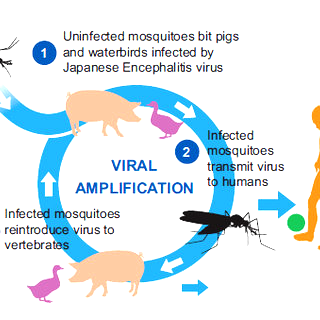
- The disease is transmitted to humans through bites from infected mosquitoes of the Culex species.
- These mosquitoes breed mainly in rice fields and large water bodies rich in aquatic vegetation.
- Migratory birds along with pigs in the community also play an important role in the transmission of JE from one area to other areas.
- Symptoms:
- Most people infected with JE do not have symptoms or have only mild symptoms.
- However, a small percentage of infected people develop inflammation of the brain (encephalitis), with symptoms including sudden onset of headache, high fever, disorientation, coma, tremors and convulsions.
- Treatment:
- There is no antiviral treatment for patients with JE. Treatment, available, is supportive to relieve symptoms and stabilise the patient.
- Prevention:
- Safe and effective JE vaccines are available to prevent the disease.
- In India, mass vaccination with JE vaccine was started in a phased manner subsequent to the major outbreak in 2005.
- JE vaccination is also included under the Universal Immunisation Program of the Government of India.
What are the Government Initiatives Related to Japanese Encephalitis?
- In order to reduce morbidity, mortality, and disability in children due to JE/AES, Government of India under National Programme for Prevention and Control of Japanese Encephalitis(JE)/ Acute Encephalitis Syndrome (NPPCJA) has developed a multi-pronged strategy with the convergence of the concerned Ministries.
- Ministry of Health and Family Welfare: Strengthening and expanding JE vaccination, Strengthening of public health activities, better clinical management of JE/AES Cases etc.
- Ministry of Jal Shakti for the provision of safe water supply.
- Women and Child development for providing high-quality nutrition to vulnerable children.
- Ministry of Social Justice and Empowerment for establishing District Disability Rehabilitation Centres for disability management and rehabilitation.
- Ministry of Housing and Urban Affairs for ensuring the supply of safe water in slums and towns.
- Ministry of Education to provide special facilities for disabled children for their education.
Statehood Day of Mizoram
Why in News?
Recently, the Prime Minister of India extended his wishes to the people of Mizoram on its 36th Statehood Day (20th February).
- The formalization of Mizoram State took place on 20th February, 1987 after the 53rd Amendment of the Indian Constitution, 1986.
What do we know about Mizoram?
- Historical background: The Mizo hills area became the Lushai Hills district within Assam at the time of independence. Further, in 1954 it was renamed the Mizo Hills District of Assam.
- Mizoram was granted the status of a Union Territory in 1972 after signing an accord with the moderates of the Mizo National Front (MNF).
- The Union Territory of Mizoram was conferred the status of a full state in 1986 after signing of a memorandum of settlement (Mizoram Peace Accord) between the Central government and the MNF.
- Geographical Location:
- International Border: Myanmar and Bangladesh
- State Border: Tripura (northwest), Assam (north) and Manipur (northeast).
- Demography: Mizoram population in 2022 is estimated to be 1.27 Million and is the second least populous state in India after Sikkim.
- The Sex Ratio is 975 female per 1000 male (National: 943).
- The Literacy rate of the state is 91.58 % (National: 74.04%).
- Biodiversity: According to India State of Forest Report (ISFR), 2021 Mizoram has the maximum forest cover as a percentage of their own geographical area at (84.53%) from the North eastern region of the country.
- State Animal: Saza (serow)
- State Bird: Vavu (Hume Bartailed Pheasant).
- Protected Areas:
- Dampa Tiger Reserve
- Murlen National Park
- Phawngpui National Park
- Ngengpui Wildlife Sanctuary
- Tawi Wildlife Sanctuary
- Tribals: It has the highest concentration (percentage) of tribal population among all states of India.
- Mizos consist of 5 major and 11 minor tribes known as Awzia. The 5 major tribes include: Lushei, Ralte, Hmar, Paihte and Pawi.
- The Mizos are a close- knit society with no class distinction and discrimination on grounds of sex, status or religion.
- Mizos are agriculturists, practise “Jhum Cultivation” or slash- and- burn system of cultivation.
- Festivals and Dance: The Mizos have two main festivals- Mim Kut and Chapchar Kut.
- Mim Kut: It is a Maize festival that is celebrated during the months of August and September, after the harvest of maize.
- Chapchar Kut: It is a Spring Festival, most popular and celebrated after completion of the task of jungle clearing for “jhum” operations.
- The most colourful and distinctive dance of the Mizo is called Cheraw. Long bamboo staves are used for this dance, therefore many people call it ‘Bamboo Dance’.
Statehood Day of Arunachal Pradesh
Why in News?
Recently, the Prime Minister of India extended his wishes to the people of Arunachal Pradesh on its 36th Statehood Day.
- Through the 55th amendment to the Indian Constitution in 1986, Arunachal Pradesh became the 24th state of the Indian Union on 20th February, 1987.
What do we Know about Arunachal Pradesh?
- Historical Background: During the British Colonial Rule, until 1972, the state was named as the North-East Frontier Agency (NEFA).
- On 20th January, 1972, it became a Union Territory and was named Arunachal Pradesh. It was granted statehood by the State of Arunachal Pradesh Act, 1986.
- Geographical location: The state was formed out of Assam in the year 1987.
- In the west, Arunachal Pradesh is bordered by Bhutan and in the north falls the Tibetan region of China.
- In the Southeastern region falls Nagaland and Myanmar and to the southwestern region falls Assam.
- Demography: The capital of Arunachal Pradesh is Itanagar.
- The total literacy rate of the state (as per Census 2011) is 65.38% with male literacy rate being 72.55% and for females, it is 57.70%.
- The Sex Ratio of the states is 938 female per 1000 male (National: 943)
- The state is home to 26 major tribes, there are more than 100 sub-tribes, many of them are still unexplored. About 65% of the population of the state is tribals.
- Occupation: Mostly the population of the state depends on Agriculture, mainly Jhum cultivation (slash and burn cultivation).
- Other cultivation of cash crops is also done like potatoes.
- Horticulture crops such as pineapple, apple, oranges, etc are also done.
- Biodiversity:
- State Animal: Mithun (also known as Gayal)
- State Bird: Hornbill
- It is also home to the Dihang Dibang Biosphere Reserve.
- Protected Areas:
- Namdapha National Park
- Mouling National Park
- Sessa Orchid Sanctuary
- Dibang Wildlife Sanctuary
- Pakke Tiger Reserve
- Tribals of Arunachal: The significant tribal groups include Monpas, Nyishis, Apatanis, Noctes and Sherdukpens.
- Monpas: They are believed to be the only nomadic tribe of northeast, inhabit the West Kameng and Tawang districts, are essentially Buddhists who follow the Mahayana sect.
- Apatanis: They practice pre-Aryan beliefs, which is evident from their worship of trees, rocks and plants amongst other things. They mainly practise bamboo cultivation.
- Noctes: Found in the Tirap district, they follow Theravada Buddhism and Animism.
- Sherdukpens: A small tribal group, they are one of the most progressive tribes that can be found in Arunachal Pradesh practising agriculture, fishing and rearing of livestock. Although they have adopted Buddhism, most of their practices still remain pre-Buddhist and more Animistic.
- Nyishis: They are the most populous tribe of Arunachal Pradesh and are mainly involved in shifting cultivation and produce rice, millet, cucumber, etc.

